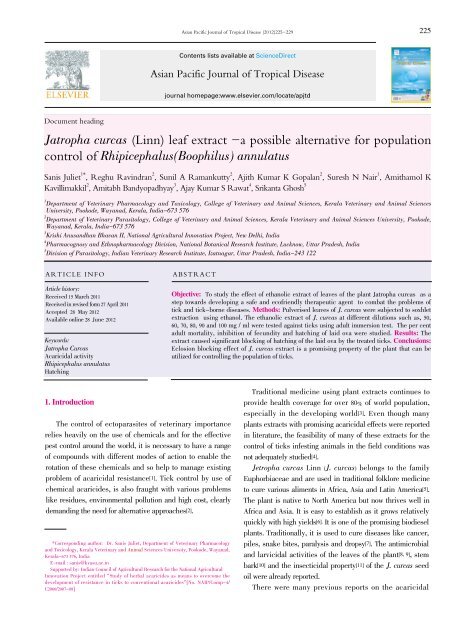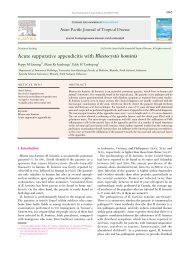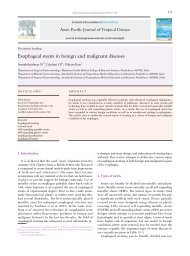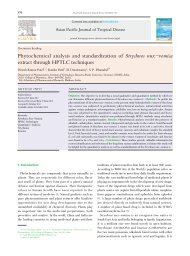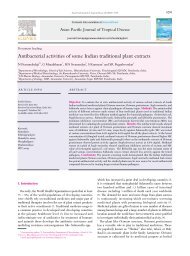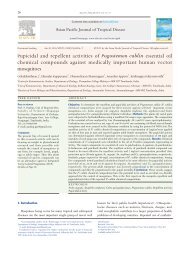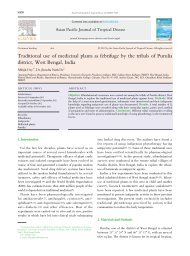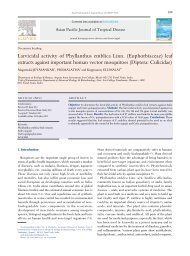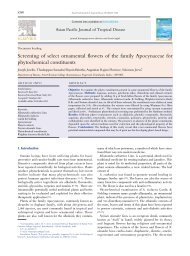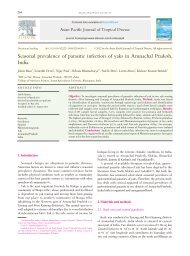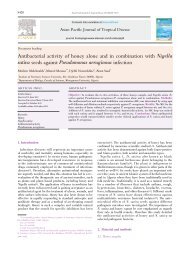Jatropha curcas (Linn) leaf extract -a possible alternative for ...
Jatropha curcas (Linn) leaf extract -a possible alternative for ...
Jatropha curcas (Linn) leaf extract -a possible alternative for ...
Create successful ePaper yourself
Turn your PDF publications into a flip-book with our unique Google optimized e-Paper software.
Document heading<br />
<strong>Jatropha</strong> <strong>curcas</strong> (<strong>Linn</strong>) <strong>leaf</strong> <strong>extract</strong> -a <strong>possible</strong> <strong>alternative</strong> <strong>for</strong> population<br />
control of Rhipicephalus(Boophilus) annulatus<br />
Sanis Juliet 1* , Reghu Ravindran 2 , Sunil A Ramankutty 2 , Ajith Kumar K Gopalan 2 , Suresh N Nair 1 , Amithamol K<br />
Kavillimakkil 2 , Amitabh Bandyopadhyay 3 , Ajay Kumar S Rawat 4 , Srikanta Ghosh 5<br />
1<br />
Department of Veterinary Pharmacology and Toxicology, College of Veterinary and Animal Sciences, Kerala Veterinary and Animal Sciences<br />
University, Pookode, Wayanad, Kerala, India-673 576<br />
2<br />
Department of Veterinary Parasitology, College of Veterinary and Animal Sciences, Kerala Veterinary and Animal Sciences University, Pookode,<br />
Wayanad, Kerala, India-673 576<br />
3<br />
Krishi Anusandhan Bhavan II, National Agricultural Innovation Project, New Delhi, India<br />
4<br />
Pharmacognosy and Ethnopharmacology Division, National Botanical Research Institute, Lucknow, Uttar Pradesh, India<br />
5<br />
Division of Parasitology, Indian Veterinary Research Institute, Izatnagar, Uttar Pradesh, India-243 122<br />
ARTICLE INFO ABSTRACT<br />
Article history:<br />
Received 15 March 2011<br />
Received in revised <strong>for</strong>m 27 April 2011<br />
Accepted 28 May 2012<br />
Available online 28 June 2012<br />
Keywords:<br />
<strong>Jatropha</strong> Curcas<br />
Acaricidal activity<br />
Rhipicephalus annulatus<br />
Hatching<br />
1. Introduction<br />
The control of ectoparasites of veterinary importance<br />
relies heavily on the use of chemicals and <strong>for</strong> the effective<br />
pest control around the world, it is necessary to have a range<br />
of compounds with different modes of action to enable the<br />
rotation of these chemicals and so help to manage existing<br />
problem of acaricidal resistance[1]. Tick control by use of<br />
chemical acaricides, is also fraught with various problems<br />
like residues, environmental pollution and high cost, clearly<br />
demanding the need <strong>for</strong> <strong>alternative</strong> approaches[2].<br />
*Corresponding author: Dr. Sanis Juliet, Department of Veterinary Pharmacology<br />
and Toxicology, Kerala Veterinary and Animal Sciences University, Pookode, Wayanad,<br />
Kerala-673 576, India<br />
E-mail : sanis@kvasu.ac.in<br />
Supported by: Indian Council of Agricultural Research <strong>for</strong> the National Agricultural<br />
Innovation Project entitled “Study of herbal acaricides as means to overcome the<br />
development of resistance in ticks to conventional acaricides”[No. NAIP/Comp-4/<br />
C2066/2007-08]<br />
Asian Pacific Journal of Tropical Disease (2012)225-229<br />
Contents lists available at ScienceDirect<br />
Asian Pacific Journal of Tropical Disease<br />
journal homepage:www.elsevier.com/locate/apjtd<br />
225<br />
Objective: To study the effect of ethanolic <strong>extract</strong> of leaves of the plant <strong>Jatropha</strong> <strong>curcas</strong> as a<br />
step towards developing a safe and ecofriendly therapeutic agent to combat the problems of<br />
tick and tick-borne diseases. Methods: Pulverised leaves of J. <strong>curcas</strong> were subjected to soxhlet<br />
<strong>extract</strong>ion using ethanol. The ethanolic <strong>extract</strong> of J. <strong>curcas</strong> at different dilutions such as, 50,<br />
60, 70, 80, 90 and 100 mg / ml were tested against ticks using adult immersion test. The per cent<br />
adult mortality, inhibition of fecundity and hatching of laid ova were studied. Results: The<br />
<strong>extract</strong> caused significant blocking of hatching of the laid ova by the treated ticks. Conclusions:<br />
Eclosion blocking effect of J. <strong>curcas</strong> <strong>extract</strong> is a promising property of the plant that can be<br />
utilized <strong>for</strong> controlling the population of ticks.<br />
Traditional medicine using plant <strong>extract</strong>s continues to<br />
provide health coverage <strong>for</strong> over 80% of world population,<br />
especially in the developing world[3]. Even though many<br />
plants <strong>extract</strong>s with promising acaricidal effects were reported<br />
in literature, the feasibility of many of these <strong>extract</strong>s <strong>for</strong> the<br />
control of ticks infesting animals in the field conditions was<br />
not adequately studied[4].<br />
Jetropha <strong>curcas</strong> <strong>Linn</strong> (J. <strong>curcas</strong>) belongs to the family<br />
Euphorbiaceae and are used in traditional folklore medicine<br />
to cure various aliments in Africa, Asia and Latin America[5].<br />
The plant is native to North America but now thrives well in<br />
Africa and Asia. It is easy to establish as it grows relatively<br />
quickly with high yields[6]. It is one of the promising biodiesel<br />
plants. Traditionally, it is used to cure diseases like cancer,<br />
piles, snake bites, paralysis and dropsy[7]. The antimicrobial<br />
and larvicidal activities of the leaves of the plant[8, 9], stem<br />
bark[10] and the insecticidal property[11] of the J. <strong>curcas</strong> seed<br />
oil were already reported.<br />
There were many previous reports on the acaricidal
226<br />
activity of essential oils from various plants against R. (B.)<br />
annulatus[12-15] and R. (B.) microplus[16-19]. Acaricidal activity<br />
of crude <strong>extract</strong>s from stem and leaves of different plants<br />
against the cattle ticks was also reported[20-25]. However, there<br />
are only meager reports on acaricidal properties of J. <strong>curcas</strong>.<br />
There<strong>for</strong>e, an attempt has been made in this study to assess<br />
the effects of leaves of J. <strong>curcas</strong> against R. (B.) annulatus,<br />
the commonest tick species in southern region of Indian<br />
subcontinent[26- 28].<br />
2. Materials and methods<br />
2.1. Plant material<br />
The J. <strong>curcas</strong> L leaves were collected from Meenangady,<br />
Sulthan Bathery Taluk of Wayanad district, Kerala. The plant<br />
was identified and the voucher specimen was deposited in<br />
the herbarium of the National Botanical Research Institute,<br />
Lucknow.<br />
2.2. Preparation of plant <strong>extract</strong><br />
The leaves were cleaned and dried in shade at room<br />
temperature. Dried plant leaves were finely pulverized using<br />
a grinder. The powdered plant material (100 g) was used<br />
<strong>for</strong> ethanolic <strong>extract</strong>ion in a soxhlet <strong>extract</strong>ion apparatus<br />
attached with rotary vacuum evaporator (Rotavac, Butchi,<br />
Switzerland). Solvent was completely removed by drying at<br />
room temperature. Required quantity of <strong>extract</strong> was weighed<br />
and dissolved in methanol <strong>for</strong> making six different dilutions at<br />
the rate of 50 mg/mL, 60 mg/mL, 70 mg/mL, 80 mg/mL, 90 mg/<br />
mL and 100 mg/mL.<br />
2.3. Ticks collection<br />
Fully engorged adult R. (B.) annulatus female ticks were<br />
collected from infested animals, washed with water and dried<br />
using tissue paper.<br />
Sanis Juliet et al./Asian Paicfic Journal of Tropical Disease (2012)225-229<br />
2.4. Adult immersion test<br />
Various dilutions (50-100 mg/mL) of ethanolic <strong>extract</strong> of the<br />
plant leaves were tested using adult immersion test[4, 29]. A<br />
total of 168 numbers of ticks were used in the experiment.<br />
Four replicates of six ticks were used <strong>for</strong> each dilution of the<br />
<strong>extract</strong>. Group of six numbers of ticks were weighed prior<br />
to the experiment and they were immersed <strong>for</strong> 2 min in the<br />
respective dilution (10 mL) in a 50 mL beaker with gentle<br />
agitation and methanol used as control. Ticks were recovered<br />
from the solution, dried using tissue paper towels and placed<br />
in separate plastic specimen tube (25 X 50 mm). The tubes<br />
were incubated at 28曟 and 80% relative humidity in a BOD<br />
incubator.<br />
2.5. Percentage of inhibition of fecundity and hatching<br />
The eggs laid by the ticks of each tube were collected,<br />
weighed and observed at the same condition of incubation <strong>for</strong><br />
the next 30 days <strong>for</strong> visual estimation of hatching. Ticks under<br />
different treatments were compared with that of controls.<br />
The percentage inhibition of fecundity was calculated as<br />
follows:<br />
Index of egg laying (IE) = weight of eggs laid (mg) / weight of<br />
females (mg)<br />
Percentage inhibition of fecundity (IF) =[IE (control group) -IE<br />
(treated group)]暳100 / IE (control group)[4].<br />
2.6. Statistical analysis<br />
Data were expressed as the mean 暲 SEM. Groups were<br />
compared using one-way ANOVA <strong>for</strong> repeated measurements<br />
using SPSS software. Duncan’s test was used <strong>for</strong> post-hoc<br />
analysis. A value of P
The results of adult immersion test using the ethanolic<br />
<strong>extract</strong> of J. <strong>curcas</strong> leaves are shown in table 1. The<br />
<strong>extract</strong> at all concentrations tested (50-100 mg / ml)<br />
considerably blocked the hatchability of eggs when<br />
compared to control. However, the <strong>extract</strong> of J. <strong>curcas</strong> did<br />
not produce mortality of adult engorged ticks. The <strong>extract</strong><br />
also did not significantly reduce the mass of eggs laid by<br />
the treated ticks. A very low percentage of inhibition of<br />
egg laying was observed. Moreover, the eggs laid by the<br />
treated ticks were apparently glossy in their appearance.<br />
4. Discussion<br />
J. <strong>curcas</strong> has long been implicated in traditional<br />
medicine and also used as an insect repellant, a<br />
mollusicide and a rodenticide[30]. The insecticidal[11]<br />
and acaricidal[31] activities of J.<strong>curcas</strong> seed oil were<br />
previously reported. The oil of J. <strong>curcas</strong> was identified as<br />
efficacious in controlling sarcoptic mange in sheep when<br />
combined with ascorbic acid[31]. J <strong>curcas</strong> seeds showed<br />
high content of unsaponifiable matter and the insecticidal<br />
activity of seed oil was attributed to the presence of<br />
sterols and triterpene alcohols[32, 33]. The by-product after<br />
<strong>extract</strong>ion of oil from the seeds of the plant also contained<br />
insecticides[34]. The antiovipositional and ovicidal effects<br />
of J. <strong>curcas</strong> against Callosobruchus maculatus Fab. were<br />
also reported. It is speculated that suffocation and / or<br />
lethal chemical poisoning due to <strong>Jatropha</strong> oil application<br />
prevented the adult emergence from the bruchid, C.<br />
maculatus[35].<br />
The acaricidal properties of plant <strong>extract</strong>s against<br />
R. (B.) microplus were attributed to terpenoids[36-39]<br />
and tannins[40]. The presence of triterpenoids, volatile<br />
oils, alkaloids, flavonoids, saponins and tannins was<br />
previously confirmed in J. <strong>curcas</strong> leaves[41]. In the present<br />
study, the ethanolic <strong>extract</strong> from the leaves of the plant<br />
did not reveal any cidal effect on adult engorged female<br />
ticks even at a concentration of 100 mg/ml. Also, in<br />
another study 5 per cent aqueous <strong>leaf</strong> and bark <strong>extract</strong>s<br />
of J.<strong>curcas</strong> revealed less acaricidal effect against spotted<br />
spider mite Tetranychus urticae Koch[42]. The larvicidal<br />
effect of methanolic <strong>leaf</strong> <strong>extract</strong> of J.<strong>curcas</strong> against the<br />
first and fourth instar larvae of Culex quinquefasciatus<br />
Say[9] was reported. In another study, the acetone <strong>extract</strong><br />
of J. <strong>curcas</strong> leaves extended the duration of the various<br />
larval instars and of pupation of Aedes aegypti even at<br />
very low concentration and showed toxicity at higher<br />
concentrations[43]. These effects could be due to very low<br />
content of triterpenoids and tannins in <strong>Jatropha</strong> leaves<br />
compared to seed oil.<br />
J. <strong>curcas</strong> <strong>extract</strong> was highly effective in controlling<br />
Sanis Juliet et al./Asian Paicfic Journal of Tropical Disease (2012)225-229 227<br />
hatching of eggs laid by the treated ticks. The eggs<br />
laid by the treated ticks were apparently glossy in their<br />
appearance. Thus, it is evident from the results of the<br />
present study that the oviposition was not at all inhibited<br />
but the eclosion was prevented. The results were<br />
consistent with the previous reports on the population<br />
limiting properties of various plant <strong>extract</strong>s. The<br />
ethanolic <strong>extract</strong>s of Leucas aspera induced a significant<br />
concentration dependent decrease in egg mass production<br />
and complete blocking of the hatching of the laid ova[25].<br />
The hexane <strong>extract</strong> of aerial parts of the plant Calea<br />
serrata inhibited hatching of B. microplus eggs, when<br />
they were immersed in the dilution of the <strong>extract</strong> and<br />
the activity was attributed to chromenes present in the<br />
plant especially the precocene II[44]. Similarily, Lysiloma<br />
latisilquum <strong>extract</strong> also showed an inhibitory effect on<br />
egg hatching at concentration of 19, 200 µg /mL[40].<br />
The molting hormones, ecdysteroids play an important<br />
role in the regulation of salivary gland function,<br />
production of pheromones, oogenesis and oviposition[45] in<br />
ticks. Ecdysone is metabolized by specific cytochrome<br />
P450 isozymes to the active <strong>for</strong>m, 20 hydroxy ecdysone (20<br />
HE). This is then transported through haemolymph to the<br />
target cells, where it binds to the ecdysone receptor to<br />
cause gene transcription[46-48].<br />
Several phytochemicals, in particular, the flavones<br />
have the potential to interact with the vertebrate estrogen<br />
receptor as agonists or antagonists. Some of the flavones<br />
like luteolin, quercetin, apigenin and chrysin were<br />
reported to inhibit ecdysone mediated gene expression<br />
in an ecdysone responsive cell line, CL8+ [49]. Apigenin<br />
inhibit both mammalian and insect cytochrome P450<br />
isozyme expression and activity. The flavones, apigenins<br />
(apigenin 7-O-β-D-neohesperidoside, apigenin 7-O-β-<br />
D-galactoside), orientin, vitexin, vicenin II and the<br />
biflavone di-C-β-Dglucopyranoside-methylene-(8,<br />
8’)-biapigenin were isolated from the leaves of J.<br />
<strong>curcas</strong>[50]. The efficacy of the <strong>extract</strong> in inhibiting the<br />
hatching of eggs laid by the treated ticks could thus be<br />
attributed to the presence of the flavone apigenin which<br />
can cause decrease in the level of active ecdysteroid by<br />
inhibiting the P450 enzyme. This could be attributed to<br />
the decreased levels of ecdysteroids leading to decreased<br />
incorporation of free ecdysteriods into the eggs or<br />
interference with the uptake of modified egg yolk protein,<br />
vitellin into the oocytes both being important <strong>for</strong> egg<br />
maturation and development.<br />
The ethanolic <strong>extract</strong> of the leaves of J. <strong>curcas</strong> L at low<br />
concentrations can significantly inhibit the hatching of<br />
laid eggs and can be considered as a <strong>possible</strong> <strong>alternative</strong><br />
<strong>for</strong> the control of ticks. The role of flavonoids and their<br />
mechanisms in modulating the tick reproduction need to
228<br />
be explored further.<br />
Conflict of interest statement<br />
We declare that we have no conflict of interest.<br />
Acknowledgements<br />
Financial support from Indian Council of Agricultural<br />
Research <strong>for</strong> the National Agricultural Innovation Project<br />
entitled “Study of herbal acaricides as means to overcome<br />
the development of resistance in ticks to conventional<br />
acaricides”[No. NAIP/Comp-4/C2066/2007-08] is<br />
thankfully acknowledged.<br />
References<br />
[1] Graf JF, Gogolewski R, Leach-bing N, Sabatini GA, Molento<br />
MB, Bordin EL et al. Tick control: an industry point of view.<br />
Parasitol 2004; 129: S427-S442.<br />
[2] Ghosh S, Azhahianambi P, Yadav MP. Upcoming and future<br />
strategies of tick control: a review. J Vector Borne Dis 2007;<br />
44:79-89.<br />
[3] WHO. Traditional medicine: growing needs and potential,<br />
WHO policy perspective on medicine. Geneva: World Health<br />
Organization; 2002, p.1-6.<br />
[4] FAO. Guidelines <strong>for</strong> resistance management and integrated<br />
parasite control in ruminants. Rome: Food and Agriculture<br />
Organization of the United Nation; 2004.<br />
[5] Burkill HM. The useful plants of West Tropical Africa<br />
(Families E-J). Kew:Royal Botanical Gardens; 1994, p. 90-94.<br />
[6] Willis TE. Text book of Pharmacognosy. London: J and A<br />
Churchill Ltd; 1967, p. 513-524.<br />
[7] Okujagu TF, Etatuvie SO, Eze I, Jimoh B, Nweke C, Mbaoji C<br />
editors. Medicinal Plants of Nigeria; South-west Nigeria. 1st<br />
Edited. Lagos: University of Lagos; 2006, p. 1-20.<br />
[8] Kalimuthu K, Vijayakumar S, Senthilkumar R. Antimicrobial<br />
activity of the biodesel plant, <strong>Jatropha</strong> <strong>curcas</strong>. Intern J Pharm<br />
Bio Sci 2010; 1(3): 1-5.<br />
[9 ] Kalimuthu K, Kadarkaral M, Savariar V, Siva K. Larvicidal<br />
efficacy of <strong>Jatropha</strong> <strong>curcas</strong> and bacterial insecticide, Bacillus<br />
thuringiensis, against lymphatic filarial vector, Culex<br />
quinquefasciatus Say(Dipteria: Culicidae). Parasitol Res<br />
2011;109(5):1251-1257<br />
[10] Igbinosa OO, Igbinosa EO, Aiyegoro OA. Antimicrobial<br />
activity and phytochemical screening of stem bark <strong>extract</strong>s<br />
from <strong>Jatropha</strong> <strong>curcas</strong> (<strong>Linn</strong>). Afr J Pharm Pharacol 2009; 3(2):<br />
58-62.<br />
[11] Adebowale KO, Adedire CO. Chemical composition and<br />
insecticidal properties of the underutilized <strong>Jatropha</strong> <strong>curcas</strong><br />
Sanis Juliet et al./Asian Paicfic Journal of Tropical Disease (2012)225-229<br />
seed oil. Afr J Biotechnol 2006; 5(10): 901-906.<br />
[12] Pirali-Kheirabadi K, Razzaghi-Abyaneh M, Halajian A.<br />
Acaricidal effect of Pelargonium roseum and Eucalyptus<br />
globulus essential oils against adult stage of Rhipicephalus<br />
(Boophilus) annulatus in vitro. Vet Parasitol 2009; 162:346-349.<br />
[13] Pirali-Kheirabadi K, da Silva JAT. Lavandula angustifolia<br />
essential oil as a novel and promising natural candidate<br />
<strong>for</strong> tick (Rhipicephalus (Boophilus) annulatus) control. Exp<br />
Parasitol 2010; 126: 184-186.<br />
[14] Pirali-Kheirabadi K, da Silva JAT. In-Vitro Assessment of<br />
the Acaricidal Properties of Artemisia annua and Zataria<br />
multiflora essential oils to control cattle ticks. Iranian J<br />
Parasitol 2011; 6: 58-65.<br />
[15] Martinez-Velazquez M, Rosario-Cruz R, Castillo-Herrera<br />
G, Flores-Fernandez JM, Alvarez AH, Lugo-Cervantes E.<br />
Acaricidal effect of essential oils from Lippia graveolens<br />
(Lamiales: Lamiaceae) and Allium sativum (Liliales:Liliaceae)<br />
against Rhipicephalus (Boophilus) annulatus (Acari: Ixodidae).<br />
J Med Entomol 2010; 48:822-827.<br />
[16] de B F Ferraz A, Balbino JM, Zini CA, Ribeiro VL, Bordignon<br />
SA, von Poser G. Acaricidal activity and chemical composition<br />
of the essential oil from three Piper species. Parasitol Res<br />
2010; 107: 243-248.<br />
[17] Ribeiro VLS, dos Santos JC, Bordignon SAL, Apel MA,<br />
Henriques AT, von Poser G. Acaricidal properties of the<br />
essential oil from Hesperozygis ringens (Lamiaceae) on the<br />
cattle tick Boophylus microplus. Bioresource Technol 2010;<br />
101:2506-2509.<br />
[18] Gazim ZC, Demarchi IG, Lonardoni MVC, Amorim ACL, Hovell<br />
AMC, Rezende CM et al. Acaricidal activity of the essential<br />
oil from Tetradenia riparia (Lamiaceae) on the cattle tick<br />
Rhipicephalus (Boophilus) microplus (Acari; Ixodidae). Exp<br />
Parasitol 2011; 129(2):175-178.<br />
[19] Ribeiro VLS, dos Santos JC, Martinsc JR, Schripsemad J,<br />
Siqueiraa IR, von Poser G et al. Acaricidal properties of the<br />
essential oil and precocene II obtained from Calea serrata<br />
(Asteraceae) on the cattle tick Rhipicephalus (Boophilus)<br />
microplus (Acari:Ixodidae).Vet Parasitol 2011; 179: 195-198.<br />
[20] Kaaya GP, Mwangi EN, Malonza MM. Acaricidal activity of<br />
Margaritaria discoidea (Euphorbiaceae) plant <strong>extract</strong>s against<br />
the ticks Rhipicephalus appendiculatus and Amblyomma<br />
variegatum (Ixodidae). Int J Acarol 2009; 21:123-129.<br />
[21] Bagavan A, Kamaraj C, Elango G, Zahir AA, Rahuman AA.<br />
Adulticidal and larvicidal efficacy of some medicinal plant<br />
<strong>extract</strong>s against tick, fluke and mosquitoes. Vet Parasitol 2009;<br />
166: 286-292.<br />
[22] Rosado-Aguilar JA, Aguilar-Caballero A, Rodriguez-Vivas<br />
RI, Borges-Argaez R, Garcia-Vazquez Z, Mendez-Gonzalez<br />
M. Acaricidal activity of <strong>extract</strong>s from Petiveria alliacea<br />
(Phytolaccaceae) against the cattle tick, Rhipicephalus<br />
(Boophilus) microplus (Acari: ixodidae). Vet Parasitol 2010;<br />
168: 299-303.<br />
[23] Habeeb SM. Ethno-Veterinary and Medical Knowledge
of Crude Plant Extracts and its Methods of Application<br />
(Traditional and Modern) <strong>for</strong> Tick Control. World Applied Sci J<br />
2010; 11: 1047-1054.<br />
[24] Madzimure SJ, Nyahangare ET, Hamudikuwanda H, Hove T,<br />
Stevenson PC, Belmain SR et al. Acaricidal efficacy against<br />
cattle ticks and acute oral toxicity of Lippia javanica (Burm F.)<br />
Trop Anim Health Prod 2011; 43: 481-489.<br />
[25] Ravindran R, Juliet S, Sunil AR, Kumar KGA, Nair SN,<br />
Amithamol KK et al. Eclosion blocking effect of ethanolic<br />
<strong>extract</strong> of Leucas aspera (Lamiaceae) on Rhipicephalus<br />
(Boophilus) annulatus. Vet Parasitol 2011;179: 287-290.<br />
[26] Rajamohanan K. Identification of vector <strong>for</strong> babesiosis of<br />
cattle in Kerala. Proceedings of All India symposium of<br />
vectors and vectors and vector born diseases, Trivandrum,<br />
Kerala.1982, p.125-128.<br />
[27] Koshy TJ, Rajavelu G, Lalitha CM. Ecology and bionomics of<br />
boophilids of Tamil Nadu. Cheiron 1982; 11:25-30.<br />
[28] Jagannath MS, Muraleedharan K, Hiregoudar LS. Prevalence of<br />
ixodid ticks of cattle at Bangalore. Indian J Anim Sci 1979; 49:<br />
890-894.<br />
[29] Drummond RO, Ernst SE, Trevino JL, Gladney WJ, Graham<br />
OH. Boophilus annulatus and Boophilus microplus laboratory<br />
tests <strong>for</strong> insecticides. J Econ Entomol 1973; 66:130-133.<br />
[30] Duke JA. CRC Handbook of Medicinal herbs. CRC Press Inc<br />
Boca Raton, FL. 1985<br />
[31] Dimri U, Sharma MC. Effects of sarcoptic mange and its<br />
control with oil of Cedrus deodara, Pongamia glabra, <strong>Jatropha</strong><br />
<strong>curcas</strong> and benzyl benzoate, both with and without ascorbic<br />
acid on growing sheep: epidemiology;assessment of clinical,<br />
haematological, cell- mediated humoral immune responses<br />
and pathology. J Vet Med A Physiol Pathol Clin Med 2004;<br />
55:71-78<br />
[32] Jazeen DH. How Southern cowpea weevil larvae (Bruchidae:<br />
Collosoruchus maculatus die on non-host seeds. Ecology 1977;<br />
58: 921-927.<br />
[33] Heftmann E. Recent advances in photochemistry. New York:<br />
Appleton Century; 1970.<br />
[34] Openshaw K. Concepts and Methods <strong>for</strong> collecting and<br />
compiling statistics in Biomas used as Energy. USA: UN<br />
statistical office New York; 1986.<br />
[35] Jadhau KB, Jadhua LD. Use of vegetable oils, plant <strong>extract</strong>s<br />
and synthetic products as protectants from pulse beetle.<br />
Callosobruchus maculatus in stored grain. Food Sci Technol<br />
1984; 21: 110-113.<br />
[36] Pereira JR, Famadas KM. The efficiency of <strong>extract</strong>s of<br />
Dahlstedtia pentaphylla (Leguminosae, Papilionoidae,<br />
Millettiedae) on Boophylus microplus (Canestrini, 1887) in<br />
artificially infested bovines. Vet Parasitol 2006; 142:192-195.<br />
[37] Fernandes F F, Freitas E P S. Acaricidal activity of<br />
oleoresinous <strong>extract</strong> from Copaifera reticulate (Legiminosae:<br />
Caesalpinioidae) against larvae of the southern cattle tick,<br />
Rhipicephalus (Boophilus) microplus (Acari:Ixodidae). Vet<br />
Parasitol 2007; 147:150-154.<br />
Sanis Juliet et al./Asian Paicfic Journal of Tropical Disease (2012)225-229 229<br />
[38] Ribeiro VLS, Togio E, Bordignon SAL, Goncalves K, von Poser<br />
G. Acaricidal properties of <strong>extract</strong>s from the aerial parts<br />
of Hipericum polyanthemum on the cattle tick Boophylus<br />
microplus. Vet Parasitol 2007; 147:199-203.<br />
[39] Magadum S, Mondal DB, Ghosh S. Comparative efficacy of<br />
Annona squamosa and Azadirachta indica <strong>extract</strong>s against<br />
Boophylus microplus Izatnagar isolate. Parasitol Res 2009; 105:<br />
1085-1091.<br />
[40] Fernandez-Salas A, Alonso-Diaz MA, Acosta-Rodriguez<br />
R, Torres-Acosta JFJ, Sandoval-Castro CA, Rodriguez-<br />
Vivas RI. In vitro acaricidal effect of tannin-rich plants<br />
against the cattle tick, Rhipicephalus (Boophilus) microplus<br />
(Acari:Ixodidae). Vet Parasitol 2011; 175:113-118.<br />
[41] Uche FI, Aprioku JS. The phytochemical constituents,<br />
analgesic and anti-inflammatory effects of methanol <strong>extract</strong> of<br />
<strong>Jatropha</strong> <strong>curcas</strong> leaves in mice and Wistar albino rats. J Appl<br />
Sci Environ Manage 2008; 12:99-102.<br />
[42] Reddy GVM, Girish R, Uma MS, Srinivas N. Acaricidal activity<br />
of aqueous <strong>extract</strong>s from leaves and bark of cinnamomum and<br />
jatropha against two spotted spider mite,Tetranychus urticae<br />
Koch. Karnataka J Agric Sci 2009; 22: 693-695.<br />
[43] Joish MM, Pathipati UR. Biological activity of certain botanical<br />
<strong>extract</strong>s as larvicides against the yellow fever mosquito, Aedes<br />
aegypti.L. J bio pests 2009; 2(1): 72-76.<br />
[44] Ribeiro VL, Avancini C, Goncalves K, Togio E, von Poser G<br />
Acaricidal activity of Calea serrata (Asteraceae) on Boophilus<br />
microplus and Rhipicephalus sanguineus. Vet Parasitol 2008;<br />
151:351-354<br />
[45] Velayutham R, Sankaradoss N, Nazeer Ahamed KFH.<br />
Protective effect of tannins from Ficus racemosa in<br />
hypercholesterolemia and diabetes induced vascular tissue<br />
damage in rats. Asian Pac J Trop Med 2012; 5(5): 367-373<br />
[46] Osadebe PO, Okoye FBC, Uzor PF, Nnamani NR, Adiele IE,<br />
Obiano NC. Phytochemical analysis, hepatoprotective and<br />
antioxidant activity of Alchornea cordifolia methanol <strong>leaf</strong><br />
<strong>extract</strong> on carbon tetrachloride-induced hepatic damage in<br />
rats. Asian Pac J Trop Med 2012: 5(4 ): 289-293<br />
[47] Kovendan K, Murugan K, Vincent S, Barnard DR. Mosquito<br />
larvicidal properties of Orthosiphon thymiflorus (Roth)<br />
Sleesen. (Family: Labiatae) against mosquito vectors,<br />
Anopheles stephensi, Culex quinquefasciatus and Aedes aegypti<br />
(Diptera: Culicidae). Asian Pac J Trop Med 2012; 5(4): 299-305<br />
[48] Rees HH. Hormonal control of tick development and<br />
reproduction. Parasitol 2004; 129: S127-S143.<br />
[49] Oberdorster E, Clay MA, Cottam DM, Wilmot FA, McLachlan<br />
JA, Milner MJ. Common phytochemicals are ecdysteroid<br />
agonists and antagonist: a <strong>possible</strong> evolutionary link between<br />
vertebrate and invertebrate steroid hormones. J Steroid<br />
Biochem Mol Biol 2001; 77: 229-238.<br />
[50] Abd-Alla HI, Moharram FA, Gaara AH, El-Safly MM.<br />
Phytoconstituents of <strong>Jatropha</strong> <strong>curcas</strong> L. leaves and their<br />
immunomodulatory activity on humoral and cell mediated<br />
response in chicks. Z Natur<strong>for</strong>sch C 2009; 64 (7-8):495-501.


